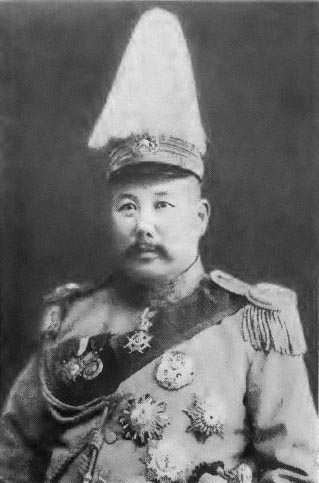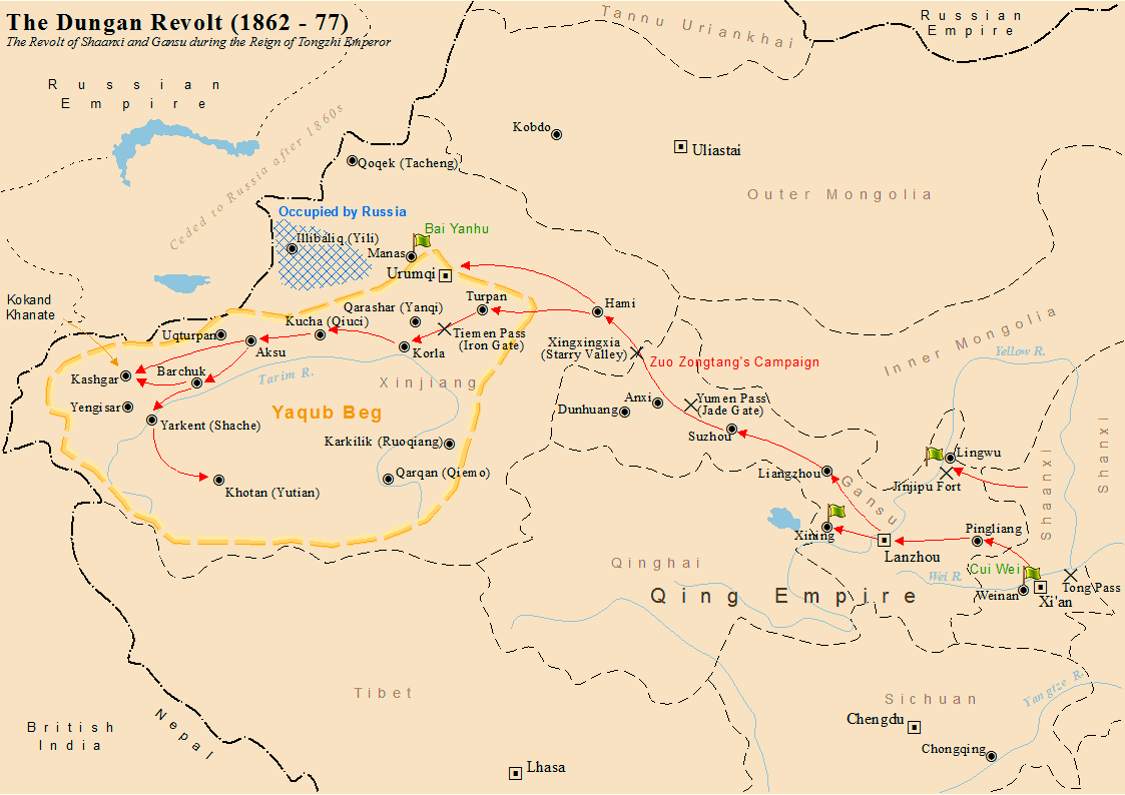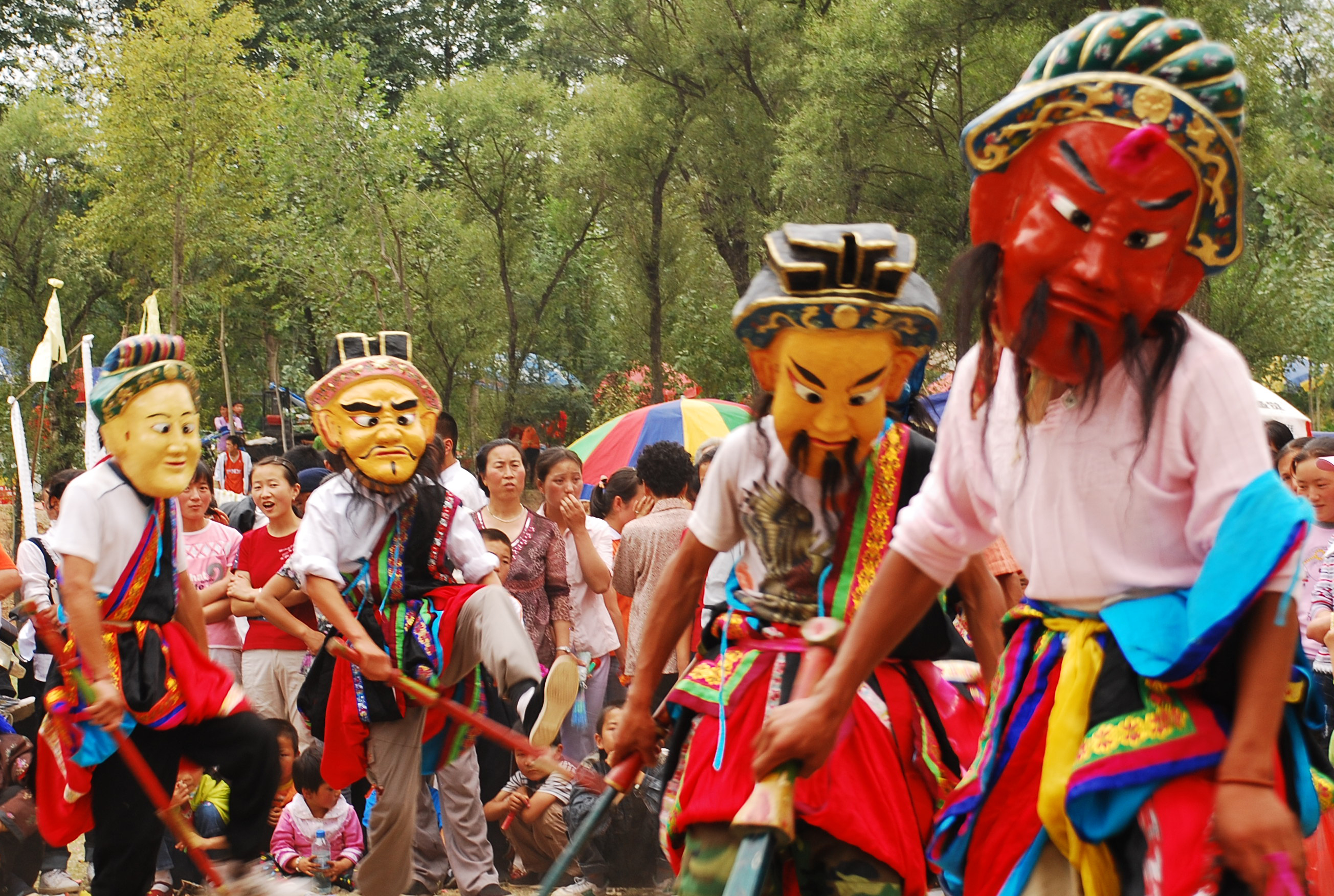|
Bonan People
The Bao’an people ( zh, s=保安族, p=Bǎo'ānzú) are a distinct ethno-linguistic group from all other Mongolic peoples, living in Gansu and Qinghai provinces in Northwestern China. They are one of the " titular nationalities" of Gansu's Jishishan Bonan, Dongxiang and Salar Autonomous County, which is located south of the Yellow River, near Gansu's border with Qinghai. Bonan are the 10th-smallest (47th out of 56) of the ethnic groups officially recognized by the People's Republic of China. 95% of Bonan live in Jishishan County, numbering 21,400 of the county's population. History The Bonan people are believed to be descended from Mongol and Central Asian soldiers stationed in Qinghai (around modern day Tongren County) during the Yuan dynasty. After the collapse of the Yuan dynasty, the ancestors of the Bonan stayed in the region and eventually intermingled with the surrounding Hui, Tibetan, Han, and Monguor peoples, which would contribute to the emergence of the moder ... [...More Info...] [...Related Items...] OR: [Wikipedia] [Google] [Baidu] |
Gansu
Gansu is a provinces of China, province in Northwestern China. Its capital and largest city is Lanzhou, in the southeastern part of the province. The seventh-largest administrative district by area at , Gansu lies between the Tibetan Plateau, Tibetan and Loess Plateau, Loess plateaus and borders Mongolia's Govi-Altai Province, Inner Mongolia and Ningxia to the north, Xinjiang and Qinghai to the west, Sichuan to the south and Shaanxi to the east. The Yellow River passes through the southern part of the province. Part of Gansu's territory is located in the Gobi Desert. The Qilian Mountains, Qilian mountains are located in the south of the Province. Gansu has a population of 26 million, ranking List of Chinese administrative divisions by population, 22nd in China. Its population is mostly Han Chinese, Han, along with Hui people, Hui, Dongxiangs, Dongxiang and Tibetan people, Tibetan minorities. The most common language is Mandarin. Gansu is among the poorest administrative divi ... [...More Info...] [...Related Items...] OR: [Wikipedia] [Google] [Baidu] |
Tongren, Qinghai
Tongren (; zh, c=同仁, p=Tóngrén), known to Tibetans as Rebgong () in the historic region of Amdo, is the capital and second smallest administrative subdivision by area within Huangnan Tibetan Autonomous Prefecture in Qinghai, China. The city has an area of 3465 square kilometers and a population of ~80,000 (2002), 75% Tibetan. The economy of the city includes agriculture and aluminium mining. Administrative divisions Tongren is made up of 3 towns and 8 townships: Demographics and languages The Amdo Tibetan is the ''lingua franca'' of Tongren and the surrounding region, which is populated by Tibetan and Hui people, as well as some Han Chinese and Mongols. The Wutun language, a Chinese- Bonan-Tibetan mixed language, is spoken by some 2,000 people in the two villages of Upper and Lower Wutun, located on the eastern bank of the Rongwo River. Culture The city has a number of Tibetan Buddhist temples and gompas, including the large and significant Rongwo Monastery of ... [...More Info...] [...Related Items...] OR: [Wikipedia] [Google] [Baidu] |
Boxer Rebellion
The Boxer Rebellion, also known as the Boxer Uprising, was an anti-foreign, anti-imperialist, and anti-Christian uprising in North China between 1899 and 1901, towards the end of the Qing dynasty, by the Society of Righteous and Harmonious Fists, known as the "Boxers" in English due to many of its members having practised Chinese martial arts, which at the time were referred to as "Chinese boxing". It was defeated by the Eight-Nation Alliance of foreign powers. Following the First Sino-Japanese War, villagers in North China feared the expansion of foreign Spheres of influence#China, spheres of influence and resented the extension of privileges to Christian missionaries, who used them to shield their followers. In 1898, North China experienced several natural disasters, including the Yellow River flooding and droughts, which Boxers blamed on foreign and Christian influence. Beginning in 1899, the movement spread across Shandong and the North China Plain, destroying foreign pro ... [...More Info...] [...Related Items...] OR: [Wikipedia] [Google] [Baidu] |
Ma Fuxiang
Ma Fuxiang (, Xiao'erjing: , French romanization: Ma-Fou-hiang or Ma Fou-siang; 4 February 1876 – 19 August 1932) was a Chinese Muslim scholar and military and political figure, spanning from the Qing Dynasty through the early Republic of China. His positions illustrated the power of family, the role of religious affiliations and the interaction of Inner Asian China and the national government of China. A prominent Muslim warlord in northwest China, Ma Fuxiang originally served under Dong Fuxiang, like other Ma Clique Muslim warlords such as Ma Anliang. Ma was born in Linxia, Gansu. He was named the military governor of Xining and then of Altay, in Qing times. He held a large number of military posts in the northwestern region after the founding of the republic. He was governor of Qinghai in 1912, Ningxia from 1912 to 1920, and Suiyuan from 1920 to 1925. Having turned to Chiang Kai-shek in 1928, he was made chairman (governor) of the government of Anhui in 1930. ... [...More Info...] [...Related Items...] OR: [Wikipedia] [Google] [Baidu] |
Ma Fulu
Ma Fulu ( zh, s=马福禄, p=Mǎ Fúlù, Xiao'erjing: ; 1854 – 1900) was a Chinese Muslim general of the Hui people, Hui ethnic group who served under the Qing dynasty. The son of General Ma Qianling and the brother of Ma Fucai, Ma Fushou and Ma Fuxiang, he was born in Linxia County, Gansu. Ma Fulu rose to prominence for his role in suppressing the Dungan revolt (1895–1896) as part of loyalist Qing Muslim forces under General Dong Fuxiang. During the Boxer Rebellion, he commanded Hui cavalry units in the "Kansu Braves" and fought in key battles against the Eight Nation Alliance, including the Battle of Langfang and the Battle of Peking (1900), where he was killed in action. His military legacy was carried on by his brother Ma Fuxiang and his son Ma Hongbin. Early life and education He was a middle born son. In 1880, Ma Fulu went to Beijing to take advanced military exams when he had an audience before the Emperor. He accidentally committed a faux pas since he did not know ... [...More Info...] [...Related Items...] OR: [Wikipedia] [Google] [Baidu] |
Dungan Revolt (1862–1877)
The Dungan Revolt (1862–1877), also known as the Tongzhi Hui Revolt (, Xiao'erjing: تُجِ خُوِ لُوًا, ) or Hui (Muslim) Minorities War, was a war fought in 19th-century western China, mostly during the reign of the Tongzhi Emperor (r. 1861–1875) of the Qing dynasty. The term sometimes includes the Panthay Rebellion in Yunnan, which occurred during the same period. However, this article refers specifically to two waves of uprising by various Chinese Muslims, mostly Hui people, Hui people, in Shaanxi, Gansu and Ningxia Province of China, provinces in the first wave, and then in Xinjiang in the second wave, between 1862 and 1877. The uprising was eventually suppressed by Qing forces led by Zuo Zongtang. The conflict began with riots by the Hui people, Hui and massacres of the Han Chinese, followed by the revenge massacres of the Hui by the Han. It resulted in massive demographic shifts in Northwest China, and led to a population loss of 21 million people from a ... [...More Info...] [...Related Items...] OR: [Wikipedia] [Google] [Baidu] |
Ma Tong
Ma, MA, or mA may refer to: Academia * Master of Arts, a degree award * Marin Academy, a high school in San Rafael, California * Menlo-Atherton High School, a public high school in Atherton, California * Minnehaha Academy, a private high school in Minneapolis, Minnesota Arts and entertainment Music * ''Ma'' (Anjan Dutt album) (1998) * ''Ma'' (Rare Earth album) (1973) * ''Ma'' (Sagarika album) (1998) * ''Ma'' (Zubeen Garg album) (2019) * '' Ma! (He's Making Eyes at Me)'', 1974 debut album of Scottish singer Lena Zavaroni * Massive Attack, a British trip hop band * In music instructions, "but", especially in the phrase ''ma non troppo'' (see Glossary of musical terminology#M) * In tonic sol-fa, a flattened me * Encyclopaedia Metallum: The Metal Archives, a website devoted to heavy metal bands Fictional characters * Ma (''The Lion King''), a main character in the animated film ''Lion King 1½'' * Ma Beagle, in the Donald Duck universe * Ma Hunkel, a DC Comics charac ... [...More Info...] [...Related Items...] OR: [Wikipedia] [Google] [Baidu] |
Ma Laichi
Ma Laichi (1681? – 1766?; ), also known as Abu 'l-Futūh Ma Laichi, was a Chinese Sufi master who brought the Khufiyya movement to China and created the Huasi ''menhuan'' ( Sufi order) - the earliest and most important Naqshbandi (نقشبندية,納克什班迪) order in Chinese Muslim history.Gladney (1996), pp. 47-48Lipman (1998), p. 65-67 Life Afaq Khoja's blessing Ma Laichi came from a Chinese Muslim family with a military background. His grandfather, Ma Congshan, was a general under the Ming dynasty; his father, Ma Jiujun, passed imperial examinations on the military track under the Qing, but instead of joining government service, made a fortune in business. His home was in Hezhou (now called Linxia), one of the main Muslim centers of Gansu. According to the legend told by Ma Laichi's followers, Ma Jiajun was still childless at the age of forty, and, desirous to have a son, he went to Xining, to ask for a blessing from Afaq Khoja, a Naqshbandi ''shaykh'' ... [...More Info...] [...Related Items...] OR: [Wikipedia] [Google] [Baidu] |
Sufi
Sufism ( or ) is a mysticism, mystic body of religious practice found within Islam which is characterized by a focus on Islamic Tazkiyah, purification, spirituality, ritualism, and Asceticism#Islam, asceticism. Practitioners of Sufism are referred to as "Sufis" (from , ), and historically typically belonged to "orders" known as (pl. ) — congregations formed around a grand (saint) who would be the last in a Silsilah, chain of successive teachers linking back to Muhammad, with the goal of undergoing (self purification) and the hope of reaching the Maqam (Sufism), spiritual station of . The ultimate aim of Sufis is to seek the pleasure of God by endeavoring to return to their original state of purity and natural disposition, known as . Sufism emerged early on in Islamic history, partly as a reaction against the expansion of the early Umayyad Caliphate (661–750) and mainly under the tutelage of Hasan al-Basri. Although Sufis were opposed to dry legalism, they strictly obs ... [...More Info...] [...Related Items...] OR: [Wikipedia] [Google] [Baidu] |
Xunhua Salar Autonomous County
Xunhua Salar Autonomous County is an autonomous county in the southeast of Haidong Prefecture, in Qinghai province, China. The autonomous county has an area of around , and a population of approximately 161,600 inhabitants per a 2022 government publication. In the east it borders the province of Gansu and in the south and the west Huangnan Tibetan Autonomous Prefecture. Its postal code is 811100 and its capital is the town of . Xunhua County is the only autonomous county where the Salar are the sole titular minority. Salar language is an official language in Xunhua, as well as in Jishishan Bonan, Dongxiang and Salar Autonomous County. As of April 2009, Xunhua is also the site of a mosque containing the oldest hand-written copy of the Quran in China, believed to have been written sometime between the 8th and 13th centuries. History Xunhua County is the location of the Bronze Age necropolis Suzhi () of the Kayue culture. Salar arrival Ethnic Salars first arrived in pr ... [...More Info...] [...Related Items...] OR: [Wikipedia] [Google] [Baidu] |
Amdo
Amdo ( �am˥˥.to˥˥ zh , c = 安多 , p = Ānduō ), also known as Domey (), is one of the three traditional Tibetan regions. It encompasses a large area from the Machu (Yellow River) to the Drichu (Yangtze). Amdo is mostly coterminous with China's present-day Qinghai province, but also includes small portions of Sichuan and Gansu provinces. In the 7th century, Amdo became a part of the Tibetan Empire until its dissolution in the 9th century. A local Tibetan theocracy called Tsongkha ruled the region from 997 to 1104. In the 13th century, Mongol forces conquered the area, which led to the beginning of a priest and patron relationship. From the 14th to the 16th century, the Ming Dynasty controlled some border areas of Amdo while Mongol presence remained significant. In the 1720s, the Yongzheng Emperor of Qing dynasty seized Amdo from the Dzungars and began forming the modern boundaries of Qinghai. He allowed most of the area to be administered by a series of local Tibet ... [...More Info...] [...Related Items...] OR: [Wikipedia] [Google] [Baidu] |
Monguor People
The Monguor people ( Monguor: Mongghul), also known as Tu people (), White Mongol or Tsagaan Mongol, are a Mongolic people and one of the 56 officially recognized ethnic groups in China. According to the 2000 census, the total population was 241,198, who mostly lived in the Qinghai and the Gansu provinces. The 2010 census gave their number as 289,565. The Monguor people speak the Monguor language, which belongs to the family of Mongolic languages but has been heavily influenced by both the local Chinese and Tibetan dialects. Today, nearly all Tu people also speak Chinese. Most are farmers and some keep livestock. Their culture and the social organizations have been influenced by Tibetan Buddhism, Confucianism, Taoism and local beliefs. A few Tu in Huzhu and Minhe are Christian, the result of on-going American and Korean missionary work in the area. Ethnic origins The ethnic history of the Monguor is contested. It has been variously suggested that their origins are relate ... [...More Info...] [...Related Items...] OR: [Wikipedia] [Google] [Baidu] |







